Before jumping straight into the new feature in the replayer, for those still getting used to the features it has, here is a quick look at the main ones that are bound to be used the most often.
Replaying moves

Obviously you can use the arrows under the board to play a move or take a move back
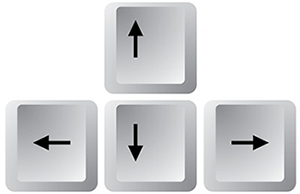
However you can also just use the arrows keys on your keyboard
Engine analysis

One of the unique features in the ChessBase replayer is the engine analysis. If you click on the engine button (looking a bit like a fan), it will open the Fritz engine and start analyzing the position. You do not need to own it or have it installed!

It may take a few seconds to start the first time, but once it does, you will see its evaluation and analysis under the board
Analyzing a game
If you wish, you can enter your own moves directly on the board, moving the pieces with your mouse, to see how they look, and consult the engine (see above) to see what it thinks.
Saving games
Needless to say, you can save the games. You have two options to do so, depending on whether there is only one game to save or many.
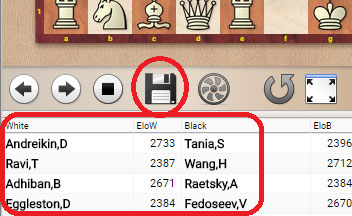
If you see a list of games below the board as above, you can choose to save them all into a PGN file for your computer by clicking on the diskette symbol below the board. This diskette will only appear if it is a base.

If you have only one game, or only want to save the game you are looking at and not all of them, then click on the diskette symbol under the notation. It will save only the opened game, but it will also save any analysis you made as well.
Opening in Fritz Online
This is the latest function added to the replayer, opening a slew of training possibilities. A common training exercise is to take a position that you would like to master and practice it by playing against someone or against an engine. Many times, the problem with the second choice is that the engine is just impossibly strong and finding a more balanced level is not always easy. With Fritz Online though, this is simple.
Let’s look at a dynamic game with plenty of fun tactics and complexity. For this purpose, here is David Navara – Hikaru Nakamura (2014), a full-blooded Classical King’s Indian. The analysis was done by GM Stohl for ChessBase Magazine and can also be found in Mega 2016.
David Navara - Hikaru Nakamura (2014)

[Event "Prague Cez Trophy m"] [Site "Prague"] [Date "2014.06.07"] [Round "1"] [White "Navara, David"] [Black "Nakamura, Hikaru"] [Result "0-1"] [ECO "E92"] [WhiteElo "2724"] [BlackElo "2775"] [Annotator "Stohl,I"] [PlyCount "92"] [EventDate "2014.06.07"] [EventType "match"] [EventRounds "4"] [EventCountry "CZE"] [SourceTitle "CBM 161"] [Source "ChessBase"] [SourceDate "2014.07.16"] 1. d4 Nf6 2. c4 g6 3. Nc3 Bg7 4. e4 d6 5. Nf3 O-O 6. h3 {Navara usually isn't too interested in the main lines.} ({This time instead of the classical} 6. Be2 {he goes for a complex system, introduced by one of Kasparov's first trainers Makogonov and taken up by his compatriot Bagirov. Later Krasenkow put it to good use and had excellent results with it, today a lot of top players use it occasionally. White's last move is multifunctional (prevents B or Ng4, introduces the possibility of g4), but White must be careful not to fall too much behind in development once the position opens up.}) 6... e5 {Typical King's Indian strategy.} (6... c5 7. d5 e6 8. Bd3 exd5 {gives White a choice, he can even recapture with the symmetrical} 9. exd5 $5 {() Already Botvinnik used to play this line, even nowadays} (9. cxd5 {- A70 is currently one of the main lines of the Benoni. Black just barely holds the balance here.}) 9... Re8+ 10. Be3 Bh6 11. O-O Bxe3 12. fxe3 Nbd7 13. Qd2 $14 {is considered rather unpleasant for Black.}) ({Black can also postpone central activity/ clarification with} 6... Na6 7. Be3 (7. g4 $6 {allows} c5 $1 8. d5 e6 {more effectively than one move earlier:} 9. Bd3 Re8 10. Kf1 Nc7 11. a4 Na6 12. Ra3 Nb4 13. Bb1 b6 14. Kg2 a6 15. Bf4 exd5 16. exd5 Ra7 $132 {Ovod,E (2420)-Sedlak, N (2580)/St Petersburg/2011/}) ({Krasenkow's move from the 1990s onwards has been} 7. Bg5 $5 c6 8. Be2 ({In his article about his pet line in CBM 132 Krasenkow prefers the flexible} 8. Nd2 $5 Ne8 (8... Qb6 9. Nb3 e5 10. d5 cxd5 11. cxd5 Bd7 12. Be3 Nc5 13. Be2 Qb4 14. Nxc5 dxc5 15. Qc2 Rfc8 16. O-O c4 17. Rfc1 Bf8 18. a3 Qa5 19. a4 Bc5 20. Nd1 $14 {Arnaudov,P (2477)-Efimenko,Z (2689) /Golden Sands/2012/}) 9. Nb3 Nac7 10. Qd2 a5 11. Rd1 a4 12. Na1 Ne6 13. Be3 Qa5 14. Nc2 Nf6 15. Be2 c5 16. d5 Nc7 17. f4 Nfe8 18. Na3 Bd7 19. O-O f5 20. exf5 gxf5 21. g4 Nf6 22. gxf5 Bxf5 23. Kh2 Ne4 24. Nxe4 Bxe4 25. Qc1 Kh8 26. Rg1 Bf6 27. Bd2 Qb6 28. Bc3 $36 {Krasenkow,M (2615)-Kempinski,R (2515)/Warsaw/1997/}) 8... e5 9. d5 h6 10. Be3 cxd5 (10... Nh5 11. dxc6 $5 bxc6 12. Qd2 Nf4 13. O-O f5 14. Bxf4 exf4 15. exf5 Bxf5 16. Rad1 Rb8 17. Nd4 $14 {Bluvshtein,M (2583) -Topalov,V (2803)/Khanty-Mansiysk olm/2010/ For more details about this game see the notes by Krasenkow in CBM 139.}) 11. cxd5 Nh5 12. Nd2 ({A simpler way is} 12. O-O Nf4 13. Bc4 $5 $13 {/+/=}) 12... Nf4 13. Bf1 Nc5 14. Nb3 b6 15. g3 Nh5 16. Qd2 $6 (16. Nd2 $5 $14) 16... Kh7 17. Be2 Nf6 18. Nxc5 bxc5 19. g4 Rb8 20. f3 Bd7 21. h4 h5 $1 22. Bg5 Qa5 23. Rg1 Rb4 $36 {Hjartarson,J (2585) -Kasparov,G (2810)/Paris rpd/1994/}) 7... e5 8. d5 Nh5 (8... c6 {is more restrained:} 9. g4 Nc5 10. Nd2 a5 11. a3 Nfd7 12. Rg1 a4 13. Qc2 Nb6 14. O-O-O Bd7 15. Kb1 cxd5 $2 (15... Rc8 $142 $5 $132) 16. cxd5 Rc8 17. Bb5 $1 { Pinpoints the strategic error on move 15.} Bxb5 18. Nxb5 Qd7 19. Nc3 Bf6 20. g5 Bd8 21. h4 Na8 22. Bxc5 Rxc5 23. Qxa4 $16 {Carlsen,M (2772)-Topalov,V (2813)/ Nanjing/2009/ For more details about this game see the notes by Krasenkow in CBM 133.}) 9. Nh2 Qe8 10. Be2 f5 $5 (10... Nf4 11. Bf3 f5 12. h4 ({Currently White more often than not plays simply} 12. O-O b6 13. Re1 Nc5 14. Bxf4 fxe4 15. Be3 exf3 16. Nxf3 Bf5 17. Bxc5 bxc5 18. Ng5 Rb8 19. Re2 Bh6 20. Nge4 Qd8 21. Ng3 Rf7 22. b3 Bf4 23. Nge4 Kg7 24. Qe1 a5 25. Rd1 Bd7 26. Qf1 h5 27. Ree1 Bh6 $11 {Figlio,G (2397)-Boger,R (2654)/email/2011/}) 12... Qe7 (12... Bd7 $5 { /\} 13. g3 Nb4 $132) 13. g3 Nb4 $5 14. O-O $1 (14. Qb3 $2 Nfd3+ 15. Ke2 f4 16. Bd2 {Kavalek,L (2595)-Kasparov,G (2630)/Bugojno/1982/} Nxf2 17. Kxf2 Nd3+ 18. Kg2 fxg3 19. Kxg3 Rf4 $1 $40) 14... g5 15. gxf4 (15. exf5 Bxf5 16. Be4 $5 $14) 15... gxf4 (15... exf4 16. Bd4 $1 {/\} Bxd4 17. Qxd4 Nc2 18. Qd2 Nxa1 19. hxg5 $16) 16. Bd2 Qxh4 17. exf5 Bxf5 18. Ne4 Nd3 19. Qe2 Nc5 20. Nxc5 dxc5 21. Be4 f3 22. Bxf3 e4 23. Bg4 Kh8 {Hausrath,D (2320)-Kaminski,M (2440)/Chania/1994/} 24. Kh1 $18) 11. exf5 (11. Bxh5 gxh5 12. g4 hxg4 13. hxg4 fxe4 14. Qb1 Qg6 15. Qxe4 Bd7 16. Ke2 Nb4 17. Rhc1 a5 18. f3 a4 19. Nf1 a3 20. b3 Qxe4 21. Nxe4 c6 22. dxc6 Bxc6 23. Nfd2 d5 $132 {Grigoryan,A (2565)-Mamedov,R (2639)/EU-ch Rijeka/2010/}) 11... Nf4 12. O-O (12. Bxf4 exf4 13. fxg6 Qxg6 $32 14. Kf1 Nc5 $44) 12... Bxf5 13. Re1 Qf7 14. Nf1 (14. Bg4 $5 Nb4 15. Bxf4 exf4 16. Ne4 $11 { Nikcevic,N (2395)-Kolev,A (2510)/St Cugat/1993/}) 14... Bxh3 $5 ({More enterprising than} 14... Nb4 $11) 15. gxh3 Nxh3+ 16. Kg2 Nxf2 17. Qb1 {Hansen, C (2570)-Kasparov,G (2800)/Svendborg m/1990/} Bh6 $1 18. Bxh6 Qd7 19. Bxf8 Rxf8 20. Bf3 Qh3+ 21. Kxf2 Qxf3+ 22. Kg1 Qf2+ 23. Kh1 Qh4+ $11 ({Black has a guaranteed draw, but he can even strive for more with} 23... Rf5 $5)) 7. d5 a5 {The most popular move. It slows White down on the queenside, but the weakening of the b5-square can backfire sometimes.} (7... Na6 {- 6...Na6}) ( 7... Nh5 8. g3 $5 a5 9. Bg2 (9. Be2 $142 Na6 10. Nh2 Nf6 11. Ng4 $13 {/+/= gives White more chances to fight for an opening advantage.}) 9... Na6 10. O-O Bd7 11. Ne1 Qe8 12. Nd3 f5 13. Re1 Nf6 14. a3 $6 (14. exf5 $11) 14... fxe4 15. Nxe4 Nxe4 16. Rxe4 Bf5 17. Re1 b5 $1 18. Nf4 Nc5 19. Ne6 Nxe6 20. dxe6 Bxe6 { Wang Hao - Bacrot, Samkir 2014.} 21. cxb5 Qxb5 22. Bxa8 Rxa8 $15 {/-/+, Wang,H (2734)-Bacrot,E (2722)/Shamkir-B/ 2014/}) (7... Ne8 $6 8. g4 $36 {is too passive - a typical motif in this line.}) 8. Bg5 ({A few days later in Dubai Nakamura had to face the ambitious} 8. g4 $5 Na6 9. Be3 Nd7 10. a3 (10. h4 Ndc5 11. Nd2 f5 $1 (11... Nb4 $6 12. Bxc5 dxc5 13. a3 Na6 14. Bd3 Qf6 15. g5 Qe7 16. Qf3 f6 17. Qg3 c6 18. Nf3 Nc7 19. O-O-O Ne8 20. Be2 Nd6 21. Kb1 Bd7 22. h5 $36 {Wang,H (2729)-Nakamura,H (2775)/Dubai blitz/2014/}) 12. gxf5 gxf5 13. f3 Qf6 14. Be2 Kh8 15. Nf1 Bh6 16. Qd2 Bxe3 17. Qxe3 f4 18. Qf2 Bd7 19. O-O-O Rg8 $15 {Divljan,I (2226)-Arencibia Rodriguez,W (2534)/Guelph/2002/}) 10... Nb6 (10... Nac5 11. Rg1 $5 (11. Nd2 Bf6 12. Nf3 a4 13. g5 Bg7 14. Nd2 f5 15. h4 c6 16. f3 Nb6 17. Be2 Bd7 $13 {Riazantsev,A (2617)-Inarkiev,E (2675)/Novokuznetsk/2008/}) (11. b4 $6 axb4 12. axb4 Rxa1 13. Qxa1 Nb3 $1 14. Qd1 Nd4 15. Nxd4 exd4 16. Bxd4 Ne5 $44) 11... a4 12. Nd2 Bf6 13. g5 Be7 14. h4 f6 15. gxf6 Bxf6 16. h5 g5 17. h6 Kh8 18. Qh5 Qe8 19. Qxe8 Rxe8 20. Nb5 Na6 21. Nf3 g4 22. Nh2 Bd8 23. Nxg4 Ndc5 24. f3 $16 {Potkin,V (2621)-Yuffa,D (2444)/Vladivostok/2014/}) 11. Rg1 Bd7 12. Nd2 a4 (12... Nc5 $5 13. Nb5 a4 14. Nc3 c6 15. g5 Rc8 16. h4 cxd5 17. cxd5 f5 $132 {Lei,T (2436)-Wang,J (2363)/Wuxi/2014/}) 13. g5 f5 14. h4 f4 $2 (14... c6 $5 $132) (14... Nxd5 $5 15. exd5 f4 16. Nde4 fxe3 17. fxe3 $13 { /+/=}) 15. Bxb6 cxb6 16. Qf3 Qc8 17. Nb5 Qc5 18. h5 gxh5 19. Bh3 $16 {->, Tomashevsky,E (2695)-Nakamura,H (2775)/Dubai rpd/2014/}) 8... Na6 9. Nd2 (9. Be2 Qe8 {can be only a transposition.} ({However, Black also has the interesting} 9... Nc5 10. Nd2 Bd7 11. g4 c6 12. h4 (12. Be3 $142 $1) 12... a4 $5 13. a3 (13. Be3 Qa5) 13... Qa5 14. Kf1 cxd5 15. cxd5 b5 16. Be3 Rab8 17. h5 b4 18. axb4 Rxb4 19. Bxc5 Qxc5 20. g5 Ne8 $15 {Grischuk,A (2792)-Morozevich,A (2731)/Dubai blitz/2014/})) 9... Qe8 ({After} 9... Nc5 {Black must reckon with the sharp} 10. g4 c6 11. Qf3 $5 a4 12. Be2 (12. O-O-O a3 13. b3 h6 14. Be3 Qa5 15. Kc2 Na6 16. Rc1 Bd7 17. Kb1 Rfc8 18. Bd3 Nc5 19. Qe2 Ne8 20. f3 Nc7 21. h4 N7a6 22. Ka1 Nb4 $132 {Borisenko,A (2429)-Fedorov,A (2603)/Kazan/2008/}) 12... Bd7 13. Rb1 Rb8 14. Kf1 h6 15. Be3 cxd5 16. cxd5 b5 17. a3 b4 18. axb4 Rxb4 19. Bxc5 dxc5 20. Nc4 Qb8 21. Qe3 Rc8 22. Rd1 Rb3 23. Qc1 $13 {Ivanisevic,I (2460) -Tosic,M (2503)/Subotica/2000/}) 10. Be2 Nd7 (10... Nc5 {is mostly met by} 11. g4 ({Krasenkow has his own recipe even here, namely} 11. h4 $5 Nh5 12. Bxh5 gxh5 13. Qxh5 Nd3+ 14. Ke2 Nf4+ 15. Bxf4 exf4 16. Rae1 Kh8 17. Kd3 Bd7 18. Nf3 b5 19. cxb5 Bxb5+ 20. Kc2 Rb8 21. e5 {Krasenkow,M (2645)-Ehlvest,J (2610)/ Polanica Zdroj/1997/} Qc8 $5 $44) 11... Bd7 (11... c6 $5 12. Be3 Rb8 13. a3 h6 14. Rb1 Bd7 15. b4 cxd5 $1 16. cxd5 Na4 17. Rc1 axb4 18. axb4 Nxc3 19. Rxc3 Qe7 20. h4 Kh7 21. Nf1 Rfc8 $132 {Ehlvest,J (2625)-Kamsky,G (2655)/Philadelphia/ 1993/}) 12. Be3 Qc8 13. Rg1 c6 14. g5 Ne8 15. h4 f5 16. Qc2 Nxe4 $6 17. Ndxe4 fxe4 18. Na4 (18. h5 $5 $36) 18... cxd5 19. Nb6 Qc6 20. Nxd7 Qxd7 21. cxd5 Nc7 22. Qxe4 a4 23. h5 a3 24. b3 $16 {Nisipeanu,L (2679)-Ajrapetjan,Y (2498)/EU-ch Legnica/2013/}) 11. a3 {Recommended also by Krasenkow in his article in CBM 134.} ({White prefers typical queenside play to the double-edged} 11. g4 Ndc5 ( 11... f6 12. Be3 Ndc5 13. Nb3 Na4 14. Nxa4 Qxa4 15. Rg1 Bd7 16. h4 Rfb8 17. Nc1 Qb4+ 18. Qd2 Nc5 19. f3 Kh8 20. Nd3 Qxd2+ 21. Kxd2 b6 22. h5 $14 {Macieja,B (2625)-Sedlak,N (2570)/EU-ch Rijeka/2010/}) 12. Nf1 (12. Rg1 Kh8 13. h4 f5 14. gxf5 gxf5 15. a3 a4 16. Bh5 Nd3+ 17. Kf1 Qd7 18. Qxa4 fxe4 19. Ndxe4 Qf5 20. Qc2 Qh3+ 21. Ke2 Nac5 22. Rg3 Rxf2+ 23. Nxf2 Qxg3 $19 {Georgescu,T (2397) -Spasov,V (2591)/Sunny Beach/2011/}) 12... f6 13. Be3 f5 14. gxf5 gxf5 15. exf5 Bxf5 16. Ng3 Qg6 17. Nxf5 Qxf5 18. Bg4 Qg6 19. Rg1 Kh8 20. Qb1 e4 $132 { Galkin,A (2540)-Ibragimov,I (2585)/Sochi/1997/ For more details about this branch see the notes to Macieja-Sedlak by Krasenkow in CBM 136.}) 11... Nb6 $5 ({Navara in his preparation concentrated on the more usual} 11... f6 12. Bh4 ( 12. Be3 $6 f5) 12... Nb6 (12... f5 $6 13. exf5 {/\} gxf5 14. Bh5 $16) 13. b3 Bh6 {Nakamura had played this in the past and returned to it in game 3, but got into big trouble after} 14. Rb1 ({but} 14. f3 {is not vigorous enough:} Be3 $1 15. Bf2 Bxf2+ 16. Kxf2 f5 17. Rb1 Qd8 18. h4 Nd7 19. h5 Nf6 20. hxg6 hxg6 21. Bd3 c6 22. Qe1 cxd5 23. Nxd5 Nxd5 24. cxd5 Nc5 $132 {Karjakin,S (2772) -Nakamura,H (2772)/Shamkir/2014/}) 14... Nc5 15. O-O (15. b4 axb4 16. axb4 Nca4 17. Nb5 Qd7 18. Qb3 Kh8 19. Nf3 f5 $1 20. O-O fxe4 21. Nh2 Bf4 22. Bg4 Qg7 23. Bxc8 Rfxc8 24. Rfe1 g5 25. Bg3 Qg6 $17 {Ostenstad,B (2465)-Nakamura,H (2783)/ ECC Rhodes/2013/}) 15... f5 $6 (15... Bd7 $142 16. Qc2 f5 17. b4 Nca4 (17... axb4 18. axb4 Nxe4 19. Ndxe4 fxe4 20. c5 Na4 21. Nxe4 Bf5 22. Bd3 Bxe4 23. Bxe4 Rf4 24. Bg3 Rxe4 25. Qxe4 Nc3 26. Qc4 Nxb1 27. Rxb1 $11 {/+/=,Raznikov,D (2433) -Klein,D (2359)/Oslo/2011/}) 18. Nb5 Bxb5 19. cxb5 Qf7 20. Rfd1 Kh8 21. Rb3 Bxd2 22. Rxd2 fxe4 23. Qxe4 Qf4 24. Qxf4 exf4 25. Bg5 axb4 26. axb4 Kg7 27. Rd4 Rf5 28. Bxf4 Nxd5 29. Bd2 Nab6 30. Bd3 Ra1+ 31. Rb1 Rxb1+ 32. Bxb1 Rh5 33. Be4 Ne7 34. Bxb7 Rxb5 $132 {Jorgensen,A (2549)-Hertel,P (2652)/email/2002/}) 16. b4 axb4 17. axb4 Nxe4 $2 (17... Nca4 18. Nb5 Qd7 19. Qc2 c5 20. Nb3 cxb4 21. c5 dxc5 22. Nxc5 Qg7 23. Rxb4 Nxc5 24. Qxc5 $16 {Krasenkow,M (2631)-Vovk,A (2506)/ Vlissingen/2009/}) (17... Bxd2 $142 18. Qxd2 Nxe4 19. Nxe4 fxe4 20. c5 $14) 18. Ndxe4 fxe4 19. c5 $1 dxc5 20. bxc5 Na4 21. Nxa4 (21. Nb5 $1 $40) 21... Qxa4 22. Be7 (22. d6 $5 $16) 22... Rf7 23. d6 cxd6 24. cxd6 Be6 25. Qxa4 Rxa4 26. Rxb7 Bf8 {Navara,D (2724)-Nakamura,H (2775)/Prague m/2014/} 27. Bb5 $1 {/\} Rb4 28. Rd1 $1 Rb2 29. Rb8 Rfxf2 30. Kh1 $1 $18) (11... h6 12. Bh4 Nb6 13. g4 a4 14. f3 Nc5 15. Qc2 c6 16. Bf2 Bd7 17. O-O-O cxd5 18. exd5 $5 f5 19. Kb1 Rc8 20. Be3 Qd8 21. h4 e4 22. fxe4 fxg4 23. h5 g5 24. Bxc5 Rxc5 25. e5 Bf5 26. Bd3 Bxd3 27. Qxd3 $36 {Movsesian,S (2698)-Grischuk,A (2763)/Istanbul olm/2012/}) 12. Be3 { A prudent retreat.} (12. b3 f5 $1 13. exf5 (13. g4 fxg4 14. hxg4 Bf6 15. Bh6 Rf7 16. Rg1 Qe7 17. Nf3 Nc5 18. Be3 Bd7 19. b4 Nba4 $1 20. bxc5 Nxc3 21. cxd6 Qxd6 22. Qd3 Na4 $13 {/=/+, Hauser,D (2213)-Gromark,P (2304)/email/2009/}) (13. O-O $5 {is an interesting, but still untested try.} f4 14. Bh4 $13 {leads to a position which is typical for the Classical line - both sides have play on opposite flanks.}) 13... gxf5 14. Bh5 Qd7 15. O-O Nc5 16. Qc2 e4 17. Rad1 Nd3 ( 17... Be5 $11) (17... Kh8 $5) 18. Be2 Be5 19. Bxd3 $5 exd3 20. Qxd3 Qg7 21. Ne2 f4 (21... Qxg5 22. f4 $36) 22. Nf3 h6 23. Nxe5 dxe5 24. Bh4 Bf5 (24... f3 25. Bg3 fxe2 26. Qxe2 $44) 25. Qc3 Kh7 26. Kh2 Nd7 {Topalov,V (2774)-Baklan,V (2627)/Kozloduy rpd/2013/} 27. g4 $16) ({Interesting and perhaps more promising is Navara's post-mortem suggestion} 12. h4 $5 f5 13. h5 {, after} h6 14. Be3 Nd7 15. f3 f4 16. Bf2 g5 17. b4 $1 $14 {|^ White's queenside play seems faster}) (12. O-O a4 13. b4 axb3 14. Nxb3 Bd7 15. c5 Na4 (15... Nxc5 $5 16. Nxc5 dxc5 17. Qb3 Na4 $132) 16. Nxa4 Bxa4 17. cxd6 cxd6 18. Qb1 Qd7 19. Nd2 b5 20. Ra2 f5 21. Rc1 Rfc8 22. Rxc8+ Rxc8 23. Rb2 Rb8 24. Kf1 h6 25. Bh4 g5 26. Bg3 f4 27. Bh2 Bf6 28. Bg1 Bd8 29. f3 Ba5 $11 {/=/+, Poluljahov,A (2450) -Georgiev,K (2625)/Tivat/1995/}) 12... Bd7 (12... f5 13. O-O f4 $2 (13... Bd7 $142 $1 14. b3 {- see the note below}) 14. Bxb6 cxb6 15. Bg4 $16 {is strategically misguided - Black should avoid this transformation.}) 13. b3 f5 14. Nb5 {This is a step in the wrong direction, especially in connection with White's follow-up.} ({A more circumspect and natural move is} 14. O-O Qe7 ( 14... Nc5 $143 $6 15. f3 Qe7 16. Qc2 {gives White extra tempi, as he doesn't have to prepare b4:} Bf6 $6 17. b4 axb4 18. axb4 Na6 19. c5 $1 Nxb4 20. Qb3 dxc5 21. d6+ Qf7 22. Bxc5 $16 {/+-, Ostenstad,B (2466)-Elsness,F (2484)/Oslo/ 2010/}) 15. Rb1 Nc5 16. Nb5 (16. f3 Bf6 $132 (16... Qh4 17. Qc2 (17. Kh2 $5 {/\ } Bh6 $2 18. g3) 17... Bh6 18. Bxh6 $6 (18. Bf2 $142) 18... Qxh6 19. b4 axb4 20. axb4 Ra3 $1 21. Rf2 Nba4 22. Nb5 Bxb5 23. cxb5 $2 {Elsness,F (2484)-Stokke, K (2408)/Oslo/2011/} (23. bxc5 Bd7 24. cxd6 cxd6 $15) 23... Rc3 $1 24. Qd1 fxe4 25. bxc5 e3 $19)) 16... c6 17. Nxd6 ({White should have preferred the modest} 17. Nc3 $142 $5 $13 {/+/=}) 17... Qxd6 18. b4 axb4 19. axb4 Nca4 20. c5 Qf6 21. dxc6 Qxc6 22. cxb6 Nc3 23. Qb3+ Kh8 24. Rbe1 Nxe2+ 25. Rxe2 Be6 26. Qb1 { Zhigalko,S (2640)-Berg,E (2616)/Khanty-Mansiysk olm/2010/} Qb5 $44) 14... Qd8 $146 {This novelty is a logical reaction, Nakamura prefers to retain his important light-squared bishop.} (14... Bxb5 $6 15. cxb5 Nc5 16. Qc2 (16. Rc1 $36) 16... fxe4 17. Nxe4 $6 (17. Bxc5 $1 dxc5 18. Nxe4 $14) 17... Nxe4 18. Qxe4 Qf7 19. O-O Kh8 20. Rfd1 Qf5 21. Bd3 Qf7 22. Rac1 Rac8 23. Be2 Nd7 24. Qc4 h5 25. Bf3 Kh7 26. Rc2 Bh6 27. Rdc1 Bxe3 28. fxe3 Kh6 $132 {Javakhishvili,L (2455) -Harika,D (2512)/Khanty-Mansiysk/2012/}) (14... Nc8 15. f3 $14 {seems too passive.}) (14... Nxd5 15. exd5 f4 16. Bb6 $5 (16. Nxc7 Nxc7 17. Bb6 e4 $1 18. Bxc7 f3 {/\} 19. Bxd6 fxg2 20. Rg1 e3 21. Bxf8 exd2+ 22. Qxd2 Bxa1 23. Bd6 Bxh3 $36) 16... e4 17. Bd4 f3 18. Bxg7 Kxg7 19. O-O fxe2 20. Qxe2 Bxb5 21. cxb5 Nc5 22. Rac1 $14) 15. Bxb6 $6 {This only helps Black by activating his forces and giving him excellent piece play.} (15. O-O $142 $1 $13 {still keeps the centre closed and the game in positional waters.} {/\} Nxc4 16. Bxc4 $5 f4 17. Bb6 Bxb5 18. Bxb5 cxb6 19. Bxa6 Rxa6 (19... bxa6 20. Rc1 $44) 20. Qg4 $44) 15... cxb6 16. Nxd6 Nc5 17. O-O Bh6 $1 18. b4 {White has managed to castle, but he must return the extra material immediately.} (18. Ra2 $143 Qf6 19. Nb5 Bxb5 20. cxb5 Bxd2 21. Rxd2 Nxe4 $36) ({A more interesting venture is the sacrificial} 18. exf5 Bxd2 19. Qxd2 Qf6 20. Nxb7 $5 Nxb3 $5 (20... Nxb7 21. fxg6 $13) 21. Qe3 Nxa1 22. Rxa1 Bc8 23. Rb1 $1 Bxb7 24. Rxb6 {, although it's not so clear if he has suffcient compensation for the whole rook after} Qf7 $13 {/=/+}) 18... Ba4 19. Qb1 Qxd6 $1 {Nakamura spurns further gains, retaining some pressure despite the equal material.} ({The text move is more circumspect than the rather reckless} 19... Na6 20. exf5 $5 (20. Nxb7 Qc7 21. b5 (21. c5 $5) 21... Nb8 22. exf5 Bxd2 23. d6 Qxb7 24. Bf3 $44) 20... gxf5 (20... Bxd2 21. Ne4 Bh6 22. fxg6 hxg6 23. b5 $44) 21. Nxb7 Qe7 22. b5 Nb8 23. d6 Qxb7 24. Bf3 e4 25. Nxe4 $36) 20. bxc5 Qxc5 21. Nf3 $6 {This inaccuracy weakens White's central control.} (21. Qb2 {is better, objectively the position is roughly equal.}) ({Navara himself preferred} 21. Ra2 $142 $5 $132) 21... fxe4 ({ Straightforward and natural, but possibly a more promising try was} 21... Rae8 $5 22. Bd3 (22. h4 b5 $5 (22... fxe4 23. Qxe4 Rf4 24. Qe3 Qxe3 25. fxe3 Re4 26. Ng5 Rxe3 27. Bg4 $132) 23. cxb5 Bc2 $15) 22... fxe4 23. Bxe4 Qxc4 24. Re1 Rf6 25. Ra2 Qc5 $15 {/~~}) 22. Qxe4 Rae8 $1 {Patient and best.} ({Nakamura took his time considering and calculating} 22... Rf4 23. Qxe5 Re8 24. Qb2 Bg7 (24... b5 25. cxb5 $5 (25. Bd1 Bg7 26. Qd2 Rxc4 27. Rb1 $132) 25... Qxd5 26. Rab1 $13 {/\} Bg7 27. Qc1 Rfe4 28. Bd1 $11) 25. Qd2 Bxa1 26. Qxf4 Rxe2 27. Ng5 Bg7 28. Qf7+ Kh8 29. Ne6 Rxe6 30. Qxe6 $1 (30. dxe6 $6 Qf5 $15) 30... Qxc4 31. Re1 $44 {Black must watch the passed pawn, also his king is exposed - he can hardly win this position. A plausible finish is} Bf8 32. Qf6+ Kg8 33. Qe6+ Kg7 34. Qe5+ $11) 23. Qh4 (23. Nxe5 $2 Bg7 $19 (23... Rf4 $19)) 23... Kg7 (23... Bf4 $5 24. g3 e4 25. gxf4 exf3 26. Bxf3 Qxc4 $15) 24. Ng5 Rf4 25. Qg3 $8 (25. Bg4 $2 Bxg5 26. Qxg5 h6 27. Qh4 h5 $19) 25... Bxg5 26. Qxg5 Bb3 27. a4 $5 $132 { Although this weakens the a-pawn, by preventing the fortifying a5-a4 it also makes Black's b6-pawn become more vulnerable.} (27. Rab1 a4 $15) 27... Re4 ( 27... h6 28. Qg3 Bxc4 29. Rac1 Qb4 (29... b5 30. axb5 Qb4 (30... Qxd5 31. Rfd1 Qxb5 32. Rxc4 Rxc4 33. Qg4 $1 Rxg4 (33... e4 34. Rd7+ Kh8 35. Bxc4 Qxc4 36. Qf4 $18) 34. Bxb5 $16) (30... Qxb5 31. Rxc4 Rxc4 32. d6 $1 $18 (32. Qg4 e4 33. Bxc4 Qxc4 34. Qd7+ Kf8 $14)) 31. Rxc4 Rxc4 32. Bd3 $5 g5 33. Bxc4 Qxc4 34. d6 {/\} Qxb5 35. h4 $36) (29... Qxd5 30. Rfd1 Qe6 31. Bxc4 Rxc4 32. Rxc4 Qxc4 33. Rd7+ Kh8 34. Qe3 Qf4 35. Qxb6 {and already Black has to find} Rf8 36. f3 Rf7 $11) 30. Bxc4 Rxc4 31. Rxc4 Qxc4 32. Rb1 Qd4 33. Qe3 $44 {/= Here the most probable outcome is a draw.}) (27... Bxc4 28. Rac1 Qxd5 29. Rfd1 Rd4 30. Kh2 $1 Rxd1 ( 30... Bxe2 $2 31. Rc7+ $18) 31. Rxd1 Qf7 32. Bxc4 Qxc4 33. Rd7+ Kg8 34. Rxb7 Qf4+ 35. Qxf4 (35. Qg3 $5) 35... exf4 36. Rxb6 Re4 37. Rb8+ Kg7 38. Rb7+ Kh6 39. h4 Rxa4 40. Kh3 $11) (27... Re7 $5 $15) 28. Rfe1 (28. Bd3 Rf4 $1 (28... Rd4 29. Qe3 Bxc4 30. Bxc4 Rxc4 31. Rfc1 $132) 29. Rae1 Qd4 $15) 28... Qd4 (28... Rf4 29. Bf3 Qd4 30. Kh1 $5 $132 (30. Ra3 Bxc4 31. Rae3 h6 32. Qg3 Bxd5 33. Rd1 Rxf3 34. Qxf3 Bxf3 35. Rxd4 exd4 36. Rxe8 Bc6 37. Rb8 Kf6 $15)) 29. Bf1 $2 { A serious mistake, now the bishop will be passive.} (29. Bf3 $142 $1 Rxe1+ 30. Rxe1 {/\} Bxc4 (30... e4 31. Qf4 $11) 31. Rd1 (31. Qc1 $5 $132) 31... Qf4 32. Qxf4 exf4 33. Rc1 $11) 29... Rxe1 30. Rxe1 Bxa4 31. h4 (31. Qg3 $5) 31... Bd7 32. h5 $2 (32. Qg3 $15 {/-/+}) (32. g3 {/\Qc1 was also better than the text move.}) 32... Qf4 $1 $19 {Nakamrua returns the extra pawn, but simplifies into a won endgame.} 33. Qxf4 exf4 34. Rb1 b5 $1 {[]} 35. cxb5 b6 36. Rc1 Rc8 37. Re1 Re8 38. Rc1 Rc8 39. Re1 Kf6 $1 {After repeating moves before the time-control Black proceeds to attack the weak pawns.} 40. hxg6 (40. d6 Re8 41. Rc1 Re6 42. Rc7 Rxd6 $19) 40... hxg6 41. d6 Rc5 42. Re4 {The last trap.} (42. Re7 Bxb5 43. Bxb5 Rxb5 44. Rb7 Ke6 $19) (42. Rd1 Ke5 $19) 42... Rc1 $1 { Highlighting one of the drawbacks of White's 29th move - the pin is decisive.} (42... Bxb5 $4 43. Bxb5 Rxb5 44. Rd4 $18) 43. Rxf4+ Ke6 44. Re4+ Kxd6 45. Rd4+ Ke6 46. Rc4 Rxf1+ (46... Rxf1+ 47. Kxf1 Bxb5 $19) 0-1
The analysis is certainly fascinating and thorough, but there are always things to look at. Consider move 21 by White. Stohl states that 21. Nf3 was an inaccuracy and that 21. Qb2 was better, or even 21. Ra2 as suggested by Navara himself. Feel like trying to play this position as Black to see how you would fare?

First click on the move you wish to face, such as Navara’s 21. Ra2.

We must first promote this move to the main game as the function only works with main moves

Then go to the toolbar under the notation and click on the “-> Fritz” button.
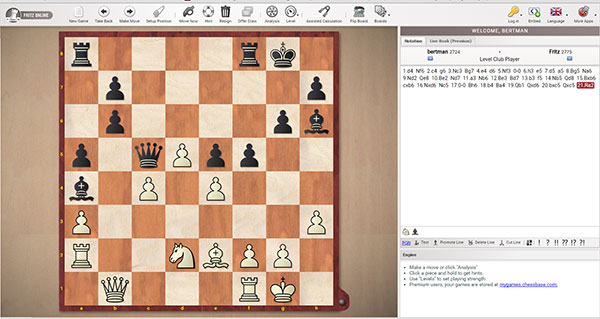
It will immediately take you to Fritz Online, with the game and position. You will notice that the other moves after have been discarded. Afterall, the idea here is to practice this position.
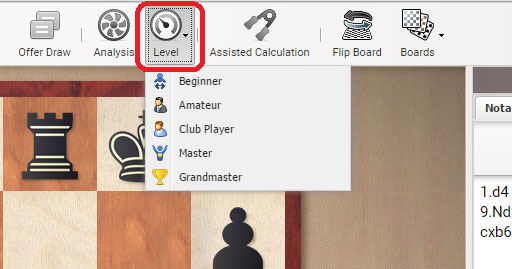
You can now flip the board if you prefer, but more importantly you can select the level Fritz will play at. What is what? Suffice it to say that Beginner and Amateur will see it blundering quite a bit, while Club Player less, and Master and Grandmaster even less. If you are rated over 2000, you will probably prefer Master for a more interesting challenge.
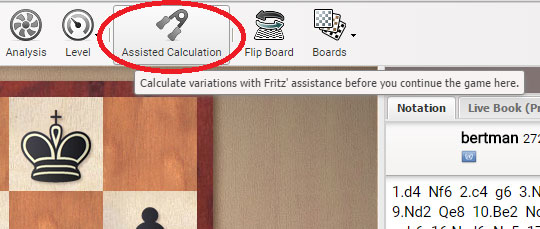
Don’t forget that in Fritz Online you also have the training tools such as Assisted Calculation that can help you work your calculation and visualization skills. For more on that, be sure to see the article explaining how it works.




































